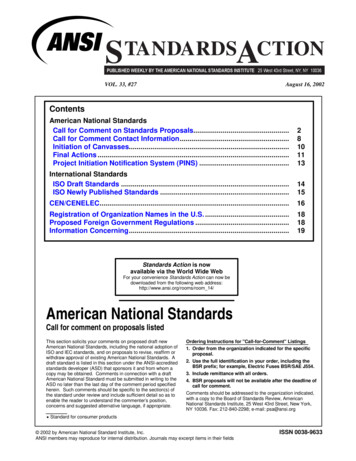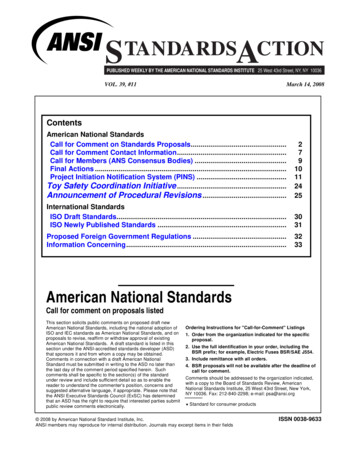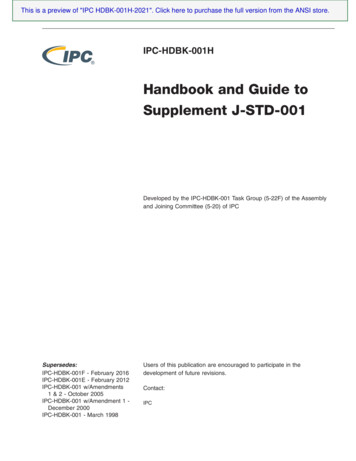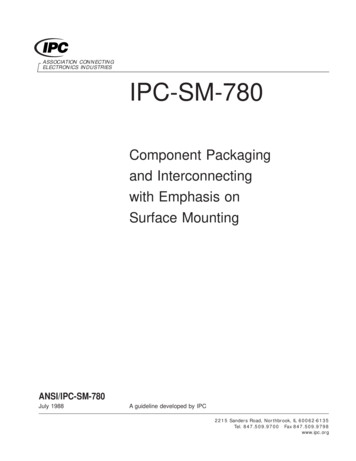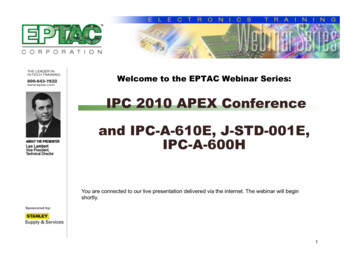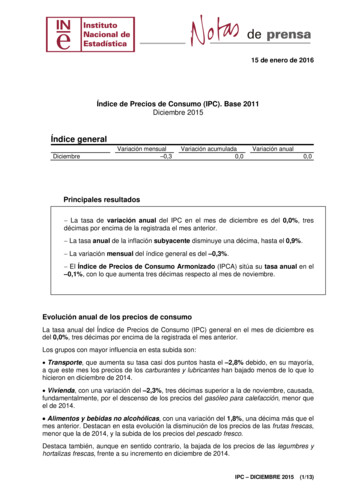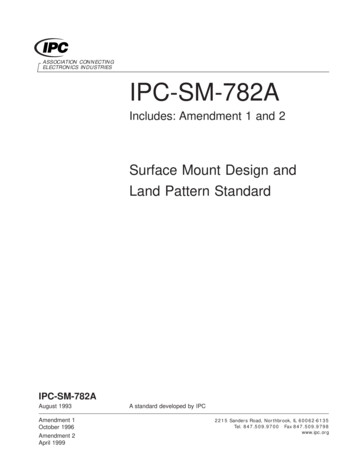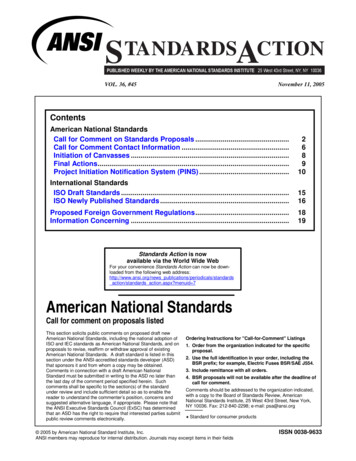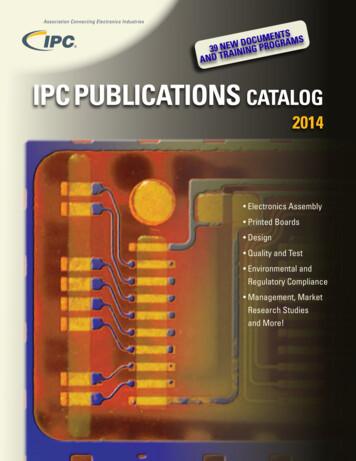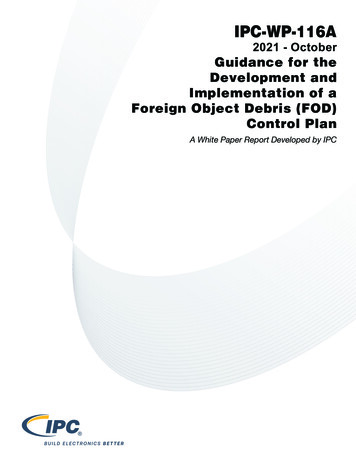
Transcription
IPC-WP-116A2021 - OctoberGuidance for theDevelopment andImplementation of aForeign Object Debris (FOD)Control PlanA White Paper Report Developed by IPC
The Principles ofStandardizationIn May 1995 the IPC’s Technical Activities Executive Committee (TAEC) adopted Principles ofStandardization as a guiding principle of IPC’s standardization efforts.Standards Should: Show relationship to Design for Manufacturability(DFM) and Design for the Environment (DFE) Minimize time to market Contain simple (simplified) language Just include spec information Focus on end product performance Include a feedback system on use andproblems for future improvementNoticeStandards Should Not: Inhibit innovation Increase time-to-market Keep people out Increase cycle time Tell you how to make something Contain anything that cannot bedefended with dataIPC Standards and Publications are designed to serve the public interest through eliminatingmisunderstandings between manufacturers and purchasers, facilitating interchangeability andimprovement of products, and assisting the purchaser in selecting and obtaining with minimumdelay the proper product for his particular need. Existence of such Standards and Publicationsshall not in any respect preclude any member or nonmember of IPC from manufacturing orselling products not conforming to such Standards and Publication, nor shall the existence of suchStandards and Publications preclude their voluntary use by those other than IPC members, whetherthe standard is to be used either domestically or internationally.Recommended Standards and Publications are adopted by IPC without regard to whether theiradoption may involve patents on articles, materials, or processes. By such action, IPC does notassume any liability to any patent owner, nor do they assume any obligation whatever to partiesadopting the Recommended Standard or Publication. Users are also wholly responsible forprotecting themselves against all claims of liabilities for patent infringement.IPC PositionStatement onSpecificationRevision ChangeIt is the position of IPC’s Technical Activities Executive Committee that the use and implementationof IPC publications is voluntary and is part of a relationship entered into by customer and supplier.When an IPC publication is updated and a new revision is published, it is the opinion of the TAECthat the use of the new revision as part of an existing relationship is not automatic unless requiredby the contract. The TAEC recommends the use of the latest revision. Adopted October 6, 1998Thank you for your continued support. Copyright 2021. IPC, Bannockburn, IL, USA. All rights reserved under both international and Pan-American copyright conventions. Anycopying, scanning or other reproduction of these materials without the prior written consent of the copyright holder is strictly prohibited andconstitutes infringement under the Copyright Law of the United States.
IPC-WP-116AGuidance for theDevelopment andImplementation of aForeign Object Debris(FOD) Control PlanDeveloped by the Wire Harness Design Task Group (7-31k)of the Product Assurance Committee (7-30) of IPCSupersedes:IPC-WP-116 December 2015Users of this publication are encouraged to participate in thedevelopment of future revisions.Contact:IPC3000 Lakeside Drive, Suite 309SBannockburn, Illinois60015-1219Tel 847 615.7100Fax 847 615.7105
This Page Intentionally Left Blank
October 2021IPC-WP-116AAcknowledgmentMembers of the Wire Harness Design Task Group worked to develop this document. We thank them for their dedication andservice to this effort. Any document involving a complex technology draws material from a vast number of sources across manycontinents. While the principal members of the Wire Harness Design Task Group (7-31k) of the Product Assurance Committee(7-30) are shown below, it is not possible to include all of those who assisted in the evolution of this standard. To each of them, themembers of the IPC extend their gratitude.Product AssuranceCommitteeWire Harness DesignTask GroupTechnical Liaison of theIPC Board of DirectorsChairRobert W. CookeNASA Johnson Space CenterChairRobert W. CookeNASA Johnson Space CenterBob NevesMicrotek (Changzhou) LaboratoriesVice-ChairDebbie WadeAdvanced Rework TechnologyVice-ChairSean KeatingAmphenol Ltd (UK)Members of Wire Harness Design Task GroupDominik AlderLockheed Martin CorporationRobert CookeNASA Johnson Space CenterEric HarenburgBoeing CompanyAnisha AnkushATRON Group LLCStephen CookeElectrical Components InternationalRick HawthorneTechnical Training CenterMichael BakerMiguel DominguezContinental Temic SA de CVGaston HidalgoToyota Motor North AmericaBill DowntonCirris Systems CorporationDavid HillmanCollins AerospaceCaroline EhlingerCollins AerospaceShelley HoltL3Harris CommunicationsChris FitzgeraldNASA Goddard Space Flight CenterIfe HsuIntel CorporationRobert FornefeldSTI Electronics, Inc.Paula JacksonRaytheon UKDaniel FosterMissile Defense Agency (MDA)Kathy JohnstonB.J. FrancoHoneywell AerospaceJoseph KaneBAE SystemsVincent BaronePanduit CorporationGeza BatizToro Co.Cathy BeckerJC ManufacturingJames BlancheNASA Marshall Space Flight CenterGerald BogertBechtel Plant Machinery, Inc.Alvin BoutteNASA Goddard Space Flight CenterBud BowenWinchester InterconnectLance BrackRaytheon Missile SystemsThomas CarleBall Aerospace &Technologies Corp.Zhiman ChenZhuzhou CRRC TimesElectric Co., LTD.Thomas CleereMahendra GandhiNorthrop Grumman Space SystemsMatt GarrettMicrosemiConstantino GonzalezACME Training & ConsultingWilliam GraverNTS - BaltimoreDave HarrellViasat Inc.Lawrence JoySean KeatingAmphenol Ltd (UK)Jason KeepingCelestica International L.P.Russell KidoPractical Components Inc.Rebekah KovarikLockheed MartinVijay KumarLockheed Martin Missiles &Fire Controliii
IPC-WP-116ALeo LambertEPTAC CorporationTheodore LaserL3Harris CommunicationsEvan LevyJohn MastoridesHoneywell AerospaceGarry McGuireNASA Marshall Space Flight CenterRandy McNuttNorthrop GrummanAerospace SystemsRoger MiedicoRaytheon CompanyBrett MillerUSA Harness, Inc.George MillmanRaytheon Missile SystemsFernando MorenoCesar-Scott, Inc.Mark NorthrupRaytheon Missile SystemsAgnieszka OzarowskiBAE SystemsBob PotysmanATRON Group LLCivOctober 2021Sue Powers-HartmanKilldeer MountainManufacturing, Inc.Stephen TisdaleTisdale EnvironmentalConsulting LLCRay PrasadRay Prasad Consultancy GroupJonathon VermillionBall Aerospace &Technologies Corp.Erik QuamUson LPEdward RiosMotorola SolutionsRichard RumasHoneywell CanadaTammy SargentCollins AerospaceMartin SciontiRaytheon Vision SystemsDarrell SensingBAE SystemsJose Servin OlivaresVitesco TechnologiesGilbert ShelbyRaytheon Systems CompanyKim SouvaKearfott CorporationToshiyasu TakeiJapan Unix Co., Ltd.Bob TeegardenHoneywell International - TorranceDaniel VersluisHYTEKDebie VorwaldCollins AerospaceDebbie WadeAdvanced Rework TechnologySchuyler WilliamsLockheed Martin Missiles &Fire ControlAlan YoungJet Propulsion LaboratoryStyle YuanWinchester Electronics(Suzhou) Co., Ltd.Jack ZhuVeoneer China CO., LTDYaakov ZissmanElta Systems Ltd.Paul ZutterU.S. Army Aviation &Missile Command
October 2021IPC-WP-116ATable of ContentsTECHNICAL BACKGROUND . . . . . . . . . . . . . . . . . . . . . . . . 11GENERAL REQUIREMENTS . . . . . . . . . . . . . . . . . . . x11.1Scope . . . . . . . . . . . . . . . . . . . . . . . . . . . . . . . . . . . . . 11.2Purpose . . . . . . . . . . . . . . . . . . . . . . . . . . . . . . . . . . . . 11.3Applicability . . . . . . . . . . . . . . . . . . . . . . . . . . . . . . . . 11.4Commercial Off-The-Shelf (COTS) . . . . . . . . . . . . . 11.5Existing of Previously Approved Designs . . . . . . . . . 11.6Measurement Units and Tolerances . . . . . . . . . . . . . . 21.7Terms and Definitions . . . . . . . . . . . . . . . . . . . . . . . . . 22APPLICABLE DOCUMENTS . . . . . . . . . . . . . . . . . . . . 22.1Industrial Standards . . . . . . . . . . . . . . . . . . . . . . . . . . 22.2Reference Documents . . . . . . . . . . . . . . . . . . . . . . . . . 23FOREIGN OBJECT DEBRIS (FOD) PREVENTIONPROGRAM . . . . . . . . . . . . . . . . . . . . . . . . . . . . . . . . . . 33.1FOD Focal Point . . . . . . . . . . . . . . . . . . . . . . . . . . . . . 33.2Housekeeping – ‘‘Clean As You Go’’ . . . . . . . . . . . . . 33.3Control of Personal Items, Tools, Hardwareand Consumables . . . . . . . . . . . . . . . . . . . . . . . . . . . . 33.4Control of Hazardous Material . . . . . . . . . . . . . . . . . . 43.5FOD Awareness and Prevention Training . . . . . . . . . 43.7FOD Incident Investigation Reporting, andCorrective Action . . . . . . . . . . . . . . . . . . . . . . . . . . . . 53.8Employee Awareness and Feedback . . . . . . . . . . . . . . 54ACRONYMS AND TERMS . . . . . . . . . . . . . . . . . . . . . . 54.1Clean-As-You-Go . . . . . . . . . . . . . . . . . . . . . . . . . . . . 54.2Cleanliness Level . . . . . . . . . . . . . . . . . . . . . . . . . . . . 54.3Commercial Off-The-Shelf (COTS) . . . . . . . . . . . . . . 54.4Complex Work . . . . . . . . . . . . . . . . . . . . . . . . . . . . . . 54.5Contaminant . . . . . . . . . . . . . . . . . . . . . . . . . . . . . . . . 54.6Critical Work . . . . . . . . . . . . . . . . . . . . . . . . . . . . . . . 64.7Discrepancy Report (DR) . . . . . . . . . . . . . . . . . . . . . . 64.8FOD Awareness Areas . . . . . . . . . . . . . . . . . . . . . . . . 64.9FOD Control Area . . . . . . . . . . . . . . . . . . . . . . . . . . . 64.10 FOD Focal Point . . . . . . . . . . . . . . . . . . . . . . . . . . . . 64.11Foreign Object Debris . . . . . . . . . . . . . . . . . . . . . . . . 64.12Foreign Object Debris (FOD) Damage . . . . . . . . . . . 64.13Material Review Record . . . . . . . . . . . . . . . . . . . . . . . 64.14Personal Items . . . . . . . . . . . . . . . . . . . . . . . . . . . . . . 6FiguresFigure 1-1Foreign Object Debris (FOD) Logo . . . . . . . . . 13.6 Measurement and Performance . . . . . . . . . . . . . . . . . 4v
IPC-WP-116AOctober 2021This Page Intentionally Left Blankvi
October 2021IPC-WP-116AGuidance for the Development and Implementation of aForeign Object Debris (FOD) Control PlanTECHNICAL BACKGROUNDMost Foreign Object Damage/Foreign Object Debris (FOD) issues can be attributed to poor housekeeping, facilities deterioration,improper maintenance, careless assembly, or inadequate operational practices. An effective FOD Prevention Program (ControlPlan) identifies potential problems, corrects negative factors, promotes awareness, provides for effective employee training, anduses ‘‘lessons learned’’ for continual improvement. The objective of any FOD Prevention Program should always be zero FOD, toprovide visibility to problem areas and trends, provide management and workers with inspection results, incident/mishap reports,and feedback of progress.1 GENERAL REQUIREMENTS1.1 Scope This document introduces design concepts, attributes, and recommendations for the control and mitigation ofperformance and reliability risks associated with the introduction of Foreign Object Debris (FOD) in electrical and electronic (E/E)assemblies, including optical and metallic cable and wiring harness assemblies, and elements thereof.1.2 Purpose The intent of this document is to provide guidance and atemplate for the development and implementation of a Foreign Object Debris(FOD) Control Plan.For purposes of this document: The Designer is the design agent for the User. The User is the individual, organization, company, contractually designatedauthority, or agency responsible for the procurement or design of electrical/ electronic / electromechanical (EEE) hardware, and having the authorityto define the class of equipment and any variation or restrictions to therequirements of this document (e.g., the originator/custodian of the contractdetailing these requirements). The User is the Design Authority. The Supplier is the individual, organization or company that providesthe Manufacturer (assembler) components (electrical, electronic,electromechanical, mechanical, printed boards, etc.) and/or materials Figure 1-1 Foreign Object Debris (FOD) Logo(solder, flux, cleaning agents, etc.). The Manufacturer is considered the entity that provides a service or product to the User.1.3 Applicability This document is targeted for control of Foreign Object Debris (FOD) in areas where both critical and complexwork is performed, and to operations involved with designing, developing, manufacturing, assembling, testing, operating, repairing,modifying, refurbishing, and maintaining Class 3 (or higher) hardware to the User specified cleanliness level.a. The design concepts, guidelines, and procedures presented in this document are for guidance ONLY, and are not requirements.As such, the use of the words ‘‘must,’’ ‘‘should’’ and ‘‘shall’’ (and derivations thereof) have no special meaning in thisdocument, and they do not indicate a binding criterion.b. This document is not binding, unless separately and specifically included by the applicable contract, approved drawing(s), orpurchase order.1.4 Commercial Off-The-Shelf (COTS) This document does not apply to Commercial-Off-The-Shelf (COTS) or catalog items(e.g., components, assemblies, subassemblies and/or hardware). Designers considering the use of COTS hardware for applicationsdescribed above are responsible for identifying and managing risks associated with hardware built without a control plan to controland/or reduce the introduction of Foreign Object Debris (FOD) in electrical and electronic (E/E) assemblies, including optical andmetallic cable and wiring harness assemblies, and elements thereof.The implementation of a Foreign Object Debris (FOD) Control Plan should notconstitute the sole cause for the redesign of previously approved designs. When drawings for existing or previously approveddesigns undergo revision, they should be reviewed and changes made that allow for compliance with the requirements ofthis document.1.5 Existing or Previously Approved Designs1
IPC-WP-116AOctober 20211.6 Measurement Units and Tolerances All dimensions and tolerances, as well as other forms of measurement in this standard areexpressed in SI (System International) units, with Imperial English equivalent dimensions provided in [brackets], except as noted.a. Linear dimensions and tolerances use centimeters (cm) [inches (in)] as the main form of dimensional expression; millimeters(mm) [inches (in)] or micrometers (µm) [microinches (µin)] are used when the required precision makes the use of centimeters(cm) too cumbersome.b. Temperature values are expressed in degrees Celsius ( C) [Fahrenheit ( F)].c. Mass is expressed in grams (g) [ounces (oz)].d. Wire, wire harness, and cable diameters are expressed in the non-dimensional unit (d), where a numerical dimension, such as2d, is solely dependent on a physical attribute of the hardware (e.g., wire gauge, harness diameter, etc.).e. Time values are expressed in hours, minutes and seconds (hh:mm:ss).f. Absolute Dimensions. For the purposes of determining conformance to this specification, all specified dimensions and/ortolerances in this standard are “absolute limits” as defined in ASTM E29 [5.1]. Actual measurement of specific dimensions anddetermination of percentages is not required, except for referee purposes, or as specified otherwise by engineering documentation.Note: This Standard uses other SI prefixes (ASTM SI10, Section 3.2), as applicable, to eliminate leading zeroes (for example,0.0012 mm becomes 1.2 μm) or as alternative to powers-of-ten (3.6 x 103 mm becomes 3.6 m).1.7 Terms and Definitions For purposes of this document, the acronyms, abbreviations, and terms used in addition to those listedin IPC-T-50 are listed in Section 4.2 APPLICABLE DOCUMENTSThe following documents are applicable to the extent specified herein. Unless otherwise specified, the issue/revision identifiedherein, or the issue/revision in effect on the date of invitation for bid, or request for proposal, will be applicable.2.1 Industrial StandardsASTM E29 Standard Practice for Using Significant Digits in Test Data to Determine Conformance with SpecificationsIPC-T-50 Terms and Definitions for Interconnecting and Packaging Electronic Circuits2.2 Reference Documents Unless otherwise specified, these documents fall in order of precedence behind the contract, approveddrawings, and any standards imposed on the program. The requirements and recommendations in these documents are not binding,are not to be construed as implied requirements to be imposed on the program, and are not to be used if they conflict with anycontractual or program-specific requirements.EV-067 (JSC) Foreign Object Debris (FOD) Control Plan for the Avionic Systems DivisionIPC-TA-724-1 Clean Rooms for Printed Circuit BoardsJPR 5335.05 JSC Foreign Object (FOD) Damage Prevention ProgramMSFC-STD-3598 MSFC Technical Standard, Standard for Foreign Object Damage/Foreign Object Debris (FOD) PreventionSAE AS9146 Foreign Object Damage (FOD) Prevention Program – Requirements for Aviation, Space, and Defense OrganizationsNote: The following section(s) of this document form a tailorable template for implementation of a Foreign ObjectDebris (FOD) Prevention Program (FOD Control Plan). The review of all ‘‘shall’’ statements and/or requirementslisted in this and subsequent sections for applicability during development of the control plan is advised. Italicized textis for informational purposes.2
October 2021IPC-WP-116A3 FOREIGN OBJECT DEBRIS (FOD) PREVENTION PROGRAMA Foreign Object Debris (FOD) Prevention Program (FOD Control Plan) shall be established for the design, development,manufacturing, assembly, repair, processing, testing, maintenance, operation, and check out of the equipment to prevent immediateand latent damage and to ensure compliance to the User specified cleanliness level.Each Supplier that manufactures, fabricates, assembles, tests, or handles hardware shall designate anindividual as the ‘‘FOD Focal Point’’ who will be responsible for developing and maintaining the FOD Control Plan.3.1 FOD Focal PointThe FOD Focal Point shall:a. Develop, update, and maintain a written FOD Control Plan in accordance with the recommendations of this document.b. Designate FOD Awareness Areas – Areas where FOD prevention, monitoring and additional training greatly reduces thelikelihood and repercussions of FOD entrapment, migration and impact damage.c. Perform a periodic FOD risk review for areas designated as FOD Awareness Areas.d. Verify that appropriate signs (conforming to Figure 1-1), barriers and other visual cues necessary to alert personnel they areentering a FOD Awareness or Control Area.e. Verify that established FOD protocols are being followed when FOD-sensitive hardware is present.f. Ensure that adequate precautions are in place and followed to protect FOD-sensitive items from damage during logisticalactivities (e.g., handling, storage, shipping, etc.).g. Determine areas within a FOD Awareness Area, if any, which may be acceptable for facilities custodial personnel to clean.h. Specify necessary FOD prevention tools (FOD containers, FOD organizer belt pouches, tethers, stanchions, etc.) for use in FODAwareness and Control Areas.i. Ensure that FOD incidents, the results of FOD walk downs, and FOD audits are documented in an official repository.j. Investigate FOD incidents and recommend corrective action.k. Ensure signs, barriers stanchions, floor tape, FOD posters, other FOD control visual cues are removed when a FOD Awarenessor Control Area is terminated.3.2 Housekeeping – ‘‘Clean As You Go’’ Employees shall be informed that housekeeping is a part of their job and that compliancewith FOD housekeeping protocols will be a part of their performance evaluation.a. Employee training and daily operations shall incorporate ‘‘clean-as-you-go’’ as a required work ethic to prevent the build-upand migration of debris.b. Floors, aisles, support structures, access platforms, and other facility surfaces shall be cleaned on a routine schedule to maintaingood housekeeping standards that enhance FOD elimination.c. Sweeping, dusting, vacuuming, and other facility cleaning methods shall remove debris in a manner that precludes migration ordistribution onto hardware or onto work surfaces that could provide a migration path to hardware.Note: Cleaning methods that continuously remove debris rather than relocate it, such as HEPA-filtered vacuum cleaners,externally exhausted vacuum systems, and damp wiping, are preferred.d. In the refurbishment or maintenance of existing facilities or construction of new facilities, all construction debris shall beremoved at the end of each task or at the end of each shift.e. Areas requiring cleaning and the extent of cleaning shall be reviewed with all involved parties (e.g., custodial contractor,facilities representative, and facility operators responsible for cleaning hardware) and agreed upon for FOD Awareness orControl.3.3 Control of Personal Items, Tools, Hardware and Consumables Personal items shall be controlled (prohibited or secured) inaccordance with the appropriate protocol for the specific FOD Awareness or Control Area.a. A protocol specific to each FOD Awareness and/or Control Area for controlling tools, small parts, and shop consumables(e.g., stock fasteners, wipers, gloves, etc.) to prevent these items from becoming FOD shall be documented.b. The appropriate protocol for each specific FOD Awareness Area shall be posted and visible prior to entry.c. Nonessential tools and materials shall not be permitted in the FOD Awareness Area.3
IPC-WP-116AOctober 2021Notes:(1) Personal items are defined as any item not identified as required for the manufacturing, fabrication, assembly, test, orquality assurance operation performed within the FOD Awareness or Control Area. Personal items include clothing items,badges and badge holders, eyeglasses, watches, personal medical devices, keys, jewelry, offıce supplies, cell phones,wallets, coins, etc.(2) The objective of a tool and small parts control program is to eliminate damage from dropped items or entrapment of FODrelated to lost tools, small parts, or consumables (e.g., solder wick, wire clippings, etc.) that are inadvertently left behindor migrate into hardware.3.4 Control of Hazardous Material Control of chemicals and process fluids, including cleaning solvents and water, is necessary toprevent accidental spillage and contamination of hardware.a. Only chemicals specified on approved work instructions shall be permitted within a FOD Awareness Area.b. Fluids shall be contained in pre-moistened wipes or in small, unbreakable, spill-proof dispenser bottles commensurate withspecific need to minimize the spill hazard.c. Dispenser bottles containing fluids shall not be placed directly on hardware.d. Overhead and inspection lighting containing light bulbs/tubes containing mercury shall not be serviced or replaced unlesscapture bags or other collection media are used to prevent accidental dropping of the bulbs onto hardware or work surfaces.Note: Light sources (e.g., bulbs, fluorescent tubes, etc.) containing mercury present a potentially serious FOD hazard tohardware and/or health concern to personnel should they fall and break. Use of light sources containing mercury shouldbe avoided when possible.3.5 FOD Awareness and Prevention Traininga. FOD Awareness Training shall:(1)be made available to all personnel to increase employee awareness to the causes and effects of FOD, promote activeinvolvement through specific techniques, and stress good work habits through work disciplines.(2)include an introduction to the causes and effects of FOD on hardware, FOD prevention approaches, familiarization withFOD control logos, signs, area agreements, and general work rules.b. FOD Prevention Training shall:(1)be made available to employees associated with development, manufacturing, fabrication, assembly, test, operations,repair, modification, refurbishment, maintenance, and transportation.(2)be required as part of initial job orientation and on a continuing basis.c. FOD Prevention Training shall include the following (at a minimum):(1)Awareness of FOD entrapment hazards and susceptibility of hardware to impact damage and to leaks and spills.(2)Personnel who are assigned to work in FOD Awareness Areas or who occasionally require entry into FOD AwarenessAreas.(3)Personnel who are assigned to work in FOD Awareness Areas or who create written lifting and handling instructions forFOD Sensitive hardware.(4)Personnel assigned to serve as FOD Monitors for FOD Awareness Areas.(5)Proper storage, shipping and handling of material, components, and equipment.(6)Techniques to control debris.3.6 Measurement and Performance FOD Control Plans shall address measurement and performance:a. The objective of any FOD Prevention Program shall always be zero FOD, to provide visibility to problem areas and trends, andprovide management and workers with inspection results, incident/mishap reports, and feedback of progress.b. The use of following measurement and performance improvement indicators is recommended:4(1)Visibility Charts – Statistical graphics derived from audit or incident data. Usually provided on a periodic schedule(e.g., weekly, monthly).(2)Trend Analysis – Where have you been? Where are you going?
October 2021(3)Report Card – A checklist of areas routinely inspected that shows specific problem areas.(4)Performance Review – A review of worker conformance to standards or expectations.(5)Customer comments, concerns, or complaints.IPC-WP-116Ac. Report Card – A checklist of areas routinely inspected that shows specific problem areas.d. Performance Review – A review of worker conformance to standards or expectations.e. Customer comments, concerns, or complaints.3.7 FOD Incident Investigation Reporting, and Corrective Action When FOD results in damage or suspected damage, the FODFocal Point shall lead an investigation into the incident and identify corrective action and recurrence control as part of the overallFOD trending and measurement assessment.a. When FOD is suspected or known to have caused damage to hardware or test article hardware, the event shall trigger aDiscrepancy Report (DR)/Material Review Record (MRR) or the appropriate nonconformance documentation for User-suppliedproduct.b. The User shall be notified of the known or suspected damage as required per the contract.Note: While a DR/MRR is initiated to flag, instigate, and disposition damage to a hardware item, the purpose of the FODinvestigation is to flag and determine corrective action for the FOD item found on or near hardware to prevent recurrence.3.8 Employee Awareness and Feedback Employee awareness and feedback is vital to continual improvement efforts, andemployees need specific information about what is wrong before they can be expected to improve processes.a. FOD signage in accordance with Figure 1-1 shall be posted at entrances and within FOD Awareness Areas to serve as a visualcue and reminder that one is entering or within a FOD Awareness Area.b. Metrics specific to the FOD Awareness Area shall be posted in a prominent location within or near the entrance to all FODAwareness Areas. These metrics shall be discussed in employee team meetings where all team members are encouraged toprovide suggestions for improvement.Note: The FOD logo shown in Figure 1-1 is a nationally recognized logo used for FOD control in the United States.4 ACRONYMS AND TERMSFor purposes of this document, the following additional acronyms and terms are listed in addition to those listed in IPC-T-50.4.1 Clean-As-You-Go The process of cleaning the immediate work area to eliminate the accumulation or migration ofForeign Object Debris that may potentially become entrapped within the product, degrade product performance or reliability, orcause damage.4.2 Cleanliness Level An established maximum allowable amount of contamination in a given area or volume, or on acomponent / part.4.3 Commercial Off-The-Shelf (COTS) Items (modules, assemblies, etc.) offered without modification and available from a vendorcatalog or stock for sale, lease, or license in substantial quantities in the commercial/consumer marketplace.4.4 Complex Work Complex work involves either: (a) the design, manufacture, fabrication, assembly, testing, integration,maintenance, or repair of machinery, equipment, subsystems, systems, or platforms, or (b) the manufacture/fabrication of parts orassemblies which have quality characteristics not wholly visible in the end item and for which conformance can only be establishedprogressively through precise measurements, tests, and controls applied.4.5 Contaminant Any unwanted matter, which could be detrimental to the required operation, reliability, or performance of a part,component, subsystem, or system.5
IPC-WP-116AOctober 20214.6 Critical Work Critical work is any hardware task that, if performed incorrectly or in violation of prescribed requirements, couldresult in loss of performance or reliability in a product where (a) continued high performance or performance-on-demand is critical,(b) equipment downtime cannot be tolerated, (c) the end-use environment may be uncommonly harsh, (d) serious injury to the Usermay result, and/or (e) the equipment must function when required (e.g., life support or other critical system, etc.).4.7 Discrepancy Report (DR) A formal report documenting a confirmed non-conformance to requirements. See also MaterialReview Record (MRR).4.8 FOD Awareness Areas Areas where FOD prevention, monitoring and additional training greatly reduces the likelihood andrepercussions of FOD entrapment, migration, and/or damage.4.9 FOD Control Area Any clearly marked and access-controlled area where introduction of foreign object debris could potentiallycause the deterioration of process control or repeatability, reduction in workmansh
An effective FOD Prevention Program (Control Plan) identifies potential problems, corrects negative factors, promotes awareness, provides for effective employee training, and uses ''lessons learned'' for continual improvement. The objective of any FOD Prevention Program should always be zero FOD, to provide visibility to problem areas .
